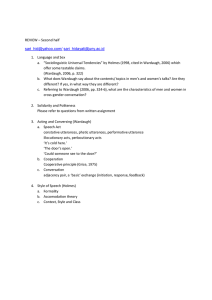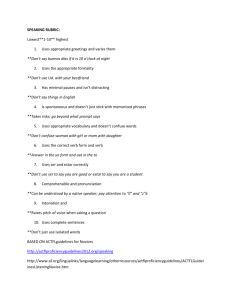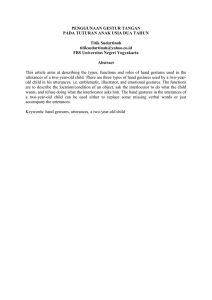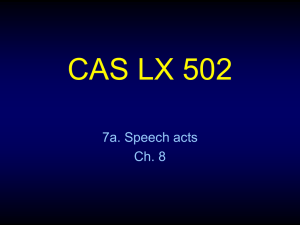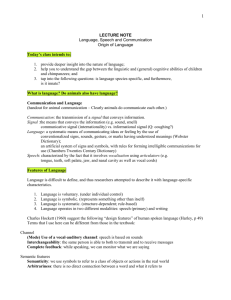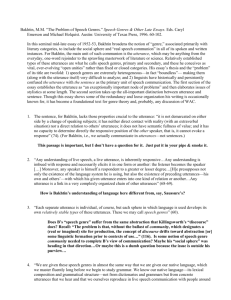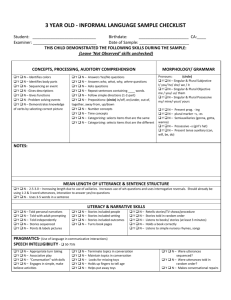Utterance types in the August database Linda Bell and Joakim Gustafson r
advertisement
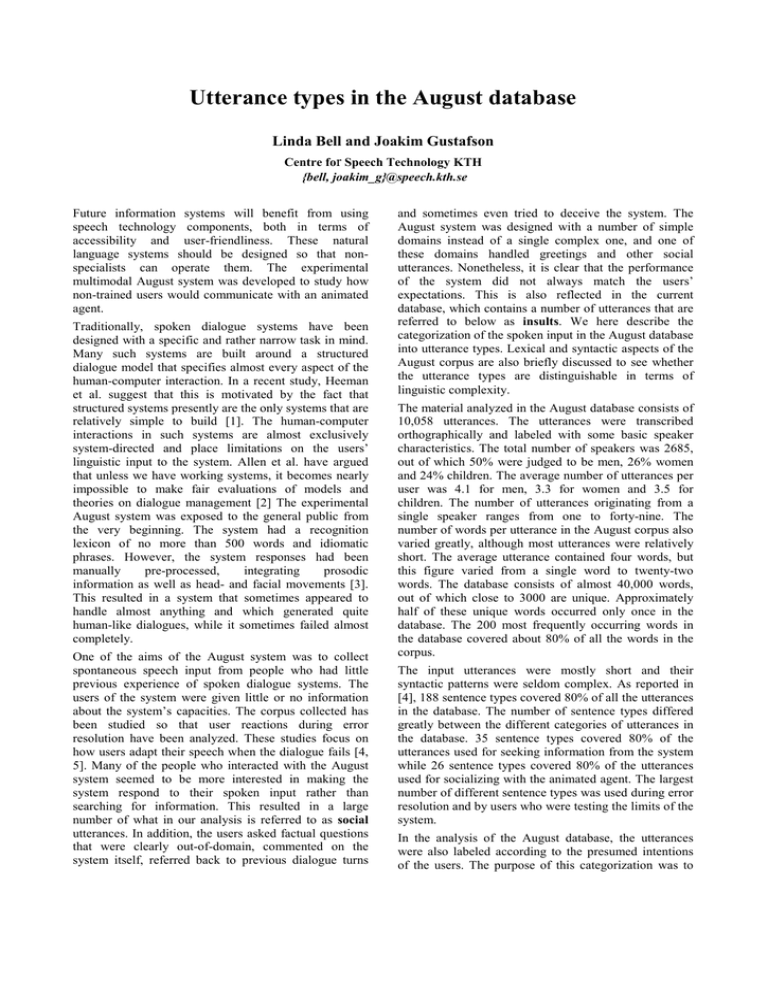
Utterance types in the August database
Linda Bell and Joakim Gustafson
Centre for Speech Technology KTH
{bell, joakim_g}@speech.kth.se
Future information systems will benefit from using
speech technology components, both in terms of
accessibility and user-friendliness. These natural
language systems should be designed so that nonspecialists can operate them. The experimental
multimodal August system was developed to study how
non-trained users would communicate with an animated
agent.
Traditionally, spoken dialogue systems have been
designed with a specific and rather narrow task in mind.
Many such systems are built around a structured
dialogue model that specifies almost every aspect of the
human-computer interaction. In a recent study, Heeman
et al. suggest that this is motivated by the fact that
structured systems presently are the only systems that are
relatively simple to build [1]. The human-computer
interactions in such systems are almost exclusively
system-directed and place limitations on the users’
linguistic input to the system. Allen et al. have argued
that unless we have working systems, it becomes nearly
impossible to make fair evaluations of models and
theories on dialogue management [2] The experimental
August system was exposed to the general public from
the very beginning. The system had a recognition
lexicon of no more than 500 words and idiomatic
phrases. However, the system responses had been
manually
pre-processed,
integrating
prosodic
information as well as head- and facial movements [3].
This resulted in a system that sometimes appeared to
handle almost anything and which generated quite
human-like dialogues, while it sometimes failed almost
completely.
One of the aims of the August system was to collect
spontaneous speech input from people who had little
previous experience of spoken dialogue systems. The
users of the system were given little or no information
about the system’s capacities. The corpus collected has
been studied so that user reactions during error
resolution have been analyzed. These studies focus on
how users adapt their speech when the dialogue fails [4,
5]. Many of the people who interacted with the August
system seemed to be more interested in making the
system respond to their spoken input rather than
searching for information. This resulted in a large
number of what in our analysis is referred to as social
utterances. In addition, the users asked factual questions
that were clearly out-of-domain, commented on the
system itself, referred back to previous dialogue turns
and sometimes even tried to deceive the system. The
August system was designed with a number of simple
domains instead of a single complex one, and one of
these domains handled greetings and other social
utterances. Nonetheless, it is clear that the performance
of the system did not always match the users’
expectations. This is also reflected in the current
database, which contains a number of utterances that are
referred to below as insults. We here describe the
categorization of the spoken input in the August database
into utterance types. Lexical and syntactic aspects of the
August corpus are also briefly discussed to see whether
the utterance types are distinguishable in terms of
linguistic complexity.
The material analyzed in the August database consists of
10,058 utterances. The utterances were transcribed
orthographically and labeled with some basic speaker
characteristics. The total number of speakers was 2685,
out of which 50% were judged to be men, 26% women
and 24% children. The average number of utterances per
user was 4.1 for men, 3.3 for women and 3.5 for
children. The number of utterances originating from a
single speaker ranges from one to forty-nine. The
number of words per utterance in the August corpus also
varied greatly, although most utterances were relatively
short. The average utterance contained four words, but
this figure varied from a single word to twenty-two
words. The database consists of almost 40,000 words,
out of which close to 3000 are unique. Approximately
half of these unique words occurred only once in the
database. The 200 most frequently occurring words in
the database covered about 80% of all the words in the
corpus.
The input utterances were mostly short and their
syntactic patterns were seldom complex. As reported in
[4], 188 sentence types covered 80% of all the utterances
in the database. The number of sentence types differed
greatly between the different categories of utterances in
the database. 35 sentence types covered 80% of the
utterances used for seeking information from the system
while 26 sentence types covered 80% of the utterances
used for socializing with the animated agent. The largest
number of different sentence types was used during error
resolution and by users who were testing the limits of the
system.
In the analysis of the August database, the utterances
were also labeled according to the presumed intentions
of the users. The purpose of this categorization was to
able to get a better overview of the utterance categories
in the database, two main groups were created from the
above mentioned six. The first one, socializing, includes
the categories social, test and insults while the second
one, information-seeking, includes the categories
domain, facts and meta. The socializing category
constituted 44% of all utterances in the corpus. Our data
40
Percentage of
all utterances
get a better picture of the kinds of things the users
wanted to convey when interacting with the system. The
concept of communicative intention is a difficult one,
both in human-human and human-computer interaction
[6]. The categorization of utterances always involves an
arbitrary element, as one and the same utterance may
express different communicative intentions depending
on the context. Nevertheless, the utterances in the
database were categorized in accordance with a
simplified pragmatic model containing six major
categories.
Table 1. The utterance types in August database.
Socializing
Social
Insult
30
20
10
0
Examples
Facts
Social
Test
Insult
men
35,6
16,4
6,4
30,8
6,0
4,9
That’s a nice mustache!
women
35,3
15,5
8,2
33,1
5,3
2,6
You are stupid!
children
28,3
12,6
7,9
37,1
6,4
7,7
Hello August!
Domain Meta
Is your brain too small
Test
What is my name?
I want to rent a refrigerator
Info-seeking
Domain
Examples
How many books did Strindberg write?
Where are the restaurants on Kungsgatan?
Meta
What can I ask you?
I told you that already!
Facts
What’s the capital of Finland?
What is two times two?
Table 1 is an overview of the utterance types in the
August database. The social category consists of
greetings and remarks of a personal kind, while expletive
expressions and swear words were placed in the category
of insults. The category called test contains utterances
that were spoken with what appeared to be the purpose
of deceiving the system. The domain category includes
utterances in one of the established domains which the
users had been given some information about. Questions
about the system itself and comments about the actual
dialogue are grouped in the meta category. Factual
questions outside the domains mostly turned out to be of
an encyclopedic nature and sometimes dealt with things
people would expect a computer to be good at, such as
calculus. These utterances are categorized as facts.
Figure 1 shows the distribution of these utterance types
in the August database. Some differences between how
men, women and children communicated with the
system can be observed. For example, children in our
study made use of social utterances to a greater extent
than adults did. One possible explanation might be that
the other domains did not particularly appeal to children.
Women rarely used insults, while the children in the
present study used them rather frequently. In order to be
Figure 1. Distribution of the utterance types.
suggest that men more often began by socializing with
the system and then turned the dialogue to the area of
information-seeking, while women more often focussed
on more domain- and fact-oriented questions from the
beginning. In contrast, many of the children used only
social utterances over the first six turns. Very few users
alternated between information-seeking and socializing
during their first six turns. There seemed to be four
distinguishable groups of users: firstly, those who only
wanted to socialize, secondly, those who only wanted to
seek for information, thirdly, those who began by
exchanging greetings and then turned to informationseeking and remained in that area. The final group was a
small one, and it consisted of users who tried to
communicate with the system, but failed, and therefore
alternated between information-seeking and socializing,
trying to get the system to understand.
To sum up, some users of the August system started by
looking for information immediately, while others
preferred to socialize with the system before going into
this mode. Almost half of all the utterances in the August
database were categorized as socializing. Children
appeared to be especially inclined to socialize with the
system, perhaps because their interest in the established
domains was low. The animated agent’s human-like
appearance probably made this social interaction make
sense.
REFERENCES
1.
Heeman, P. A., Johnston M. Denney J., Kaiser, E.
(1998) Beyond structured dialogues: Factoring out
grounding. In Proceedings of ICSLP ‘98
2.
Allen J F et al. (1996) A Robust System for Natural
Spoken Dialogue In Proc.of 34th meeting of the
Association for Computational Linguistics
3.
Gustafson, J., Lindberg, N. and Lundeberg, M.
(1999) The August Spoken Dialogue System,
Forthcoming in Proceedings of Eurospeech ‘99
4.
Bell, L. and Gustafson, J (1999) Interaction with an
animated agent in a spoken dialogue system.
Forthcoming in Proceedings of Eurospeech ‘99.
5.
Bell, L. and Gustafson, J. (1999) Repetition and its
phonetic realizations: Investigating a Swedish
database of spontaneous computer-directed speech.
In Proceedings of ICPhS ‘99
6.
Cohen P., Morgan, J. and Pollack, M. E. (eds.)
(1990) Intentions in Communication. Cambridge:
MIT Press
